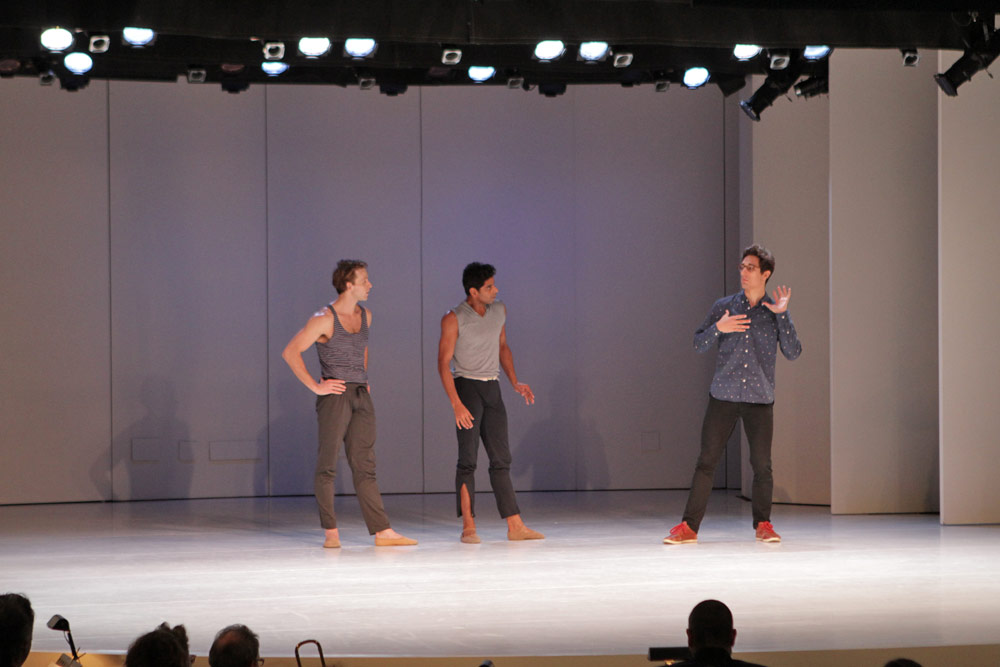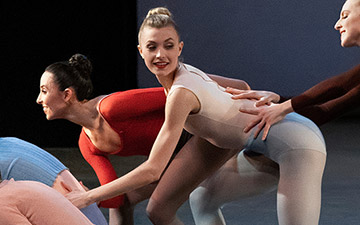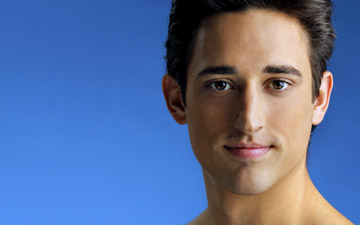
© Paul Kolnik. (Click image for larger version)
New York City Ballet
Spring Gala: Fanfare for a New Theater, If I Loved You, Allegro Brillante and Everywhere We Go
New York, David H. Koch Theater
8 May 2014
www.nycballet.com
The Widening Gyre
This year, the spring gala at New York City Ballet was an opportunity to celebrate something old – the New York State Theatre, inaugurated fifty years ago, and more recently re-Christened the David H. Koch – as well as something new, a ballet by Justin Peck, a young choreographer whose imagination seems to be exploding with ideas. The evening began with the usual crowded cocktails on the promenade – filled with tables for the subsequent dinner – and parade of dresses.
Once everyone had settled in, the proceedings opened with two onstage trumpeters playing Stravinsky’s thrilling Fanfare for a New Audience, the aural equivalent of Duchamp’s Nude Descending a Staircase – or the shattering of a mirror – all slivers and shards of sound. Peter Martins spoke and offered a toast. There was a short film about the opening of the theatre, with extraordinary images of the hall in construction, its half-shell still open to the sky. Peter Martins invited a group of former dancers to appear onstage, to a great thundering ovation. Among them: Arthur Mitchell, Jacques D’Amboise, Edward Villella, Conrad Ludlow, Jillana. All greats. But where was Suzanne Farrell?
Two heavily-miked Broadway-style singers, Kristen Bell (of the Disney film Frozen) and Aaron Lazar, sang “If I loved You,” from the musical Carousel, an excerpt of which was also performed on opening night in 1964. It was rather sad to see that City Opera, with whom the Ballet shared the theatre for almost five decades, was neither mentioned nor remembered. The opera moved in soon after the ballet, in 1966, and remained there until 2011, two years before financial troubles and a confused artistic mission finally brought it down. Too much of a downer, I guess.
Then, finally, came the dancing. Sara Mearns and Jared Angle gave a dynamic performance of Balanchine’s Allegro Brillante, with the Tchaikovsky Third Piano Concerto played at breakneck speed under the baton of Andrews Sill. (The pianist, Cameron Grant, must have had to soak his fingers in cold water afterwards.) What an exciting piece it is; even before the curtain rises, it seems, the stage is a vortex of movement. The ballerina never stops, her body swept up by the piano as if by a tornado. Mearns, never one to hold back, fed off of the music’s driving, Romantic sweep. The entire ballet feels a bit like a finale, a breathless whirlwind of spins, vaulting piqués, and diving arabesques. Jared Angle, an able, suave, and self-effacing partner – though not a particularly exciting dancer at this point in his career – allows Mearns to dance with her usual ferocious attack, knowing that he will always be there when needed. Their partnership has the air of a lively, witty conversation.

© Jacklyn Meduga/Works & Process at the Guggenheim. (Click image for larger version)
And then, finally, the première: Everywhere We Go. Justin Peck (interview) has gone from unknown corps-member to choreographer-of-the-moment in a blink of an eye. (He created his first piece for the company in 2012; this is his sixth.) Expectations are almost unreasonably high. And one can see why. Like Paz de la Jolla and Year of the Rabbit before it, Everwhere We Go is ingenious, imaginative, fast-paced, complex, densely packed. Peck has the mind of a mathematician; he finds ways to subdivide the stage and keep the eye continually guessing. Shapes appear momentarily and dissolve, only to reappear again somewhere else. Soloists weave in and out of the ensemble. The body is also subdivided in surprising ways: sometimes only the arms move, in complex phrases combining staccato and stretched combinations; other times, just the torso, or just legs. Or he has them all going at once, using momentum, gravity, and torque to set the body ablaze. And he hears everything in the music, peeling away layers and showing sounds we might otherwise miss.
Everywhere’s commissioned score, by the singer-songwriter-sometime-electronic-composer Sufjan Stevens, is rhythmic, at times bombastic, and rather brass-heavy. At times, it sounds a little bit like something written for a highly-skilled marching band (one that’s able to count bars of seven or nine beats). It’s less interesting than the music for Year of the Rabbit (also by Stevens), but it has its moments. I especially liked a section that sounded like two cuckoo-clocks going at the same time. But it’s a little relentless; it plows from one climax to the next, without enough contrast in between. In contrast, the stage designs, by Karl Jensen, are some of the best I’ve seen; patterned cut-out drops that slide past each other creating shifting shapes, rhombuses and squares that almost look three-dimensional. They enliven the space above the dancers without distracting from the dancing. And the way the light (by Brandon Stirling Baker) shines through them creates the illusion of a space behind, a glowing sun. (Janie Taylor’s sporty costumes, in contrast, are not particularly flattering, especially for the women.)

© Paul Kolnik. (Click image for larger version)
The ballet is a suite in nine sections, each with its own title. In retrospect, these do subtly suggest themes in the choreography. In “To Live in the Hearts We Leave Behind,” a man (Robert Fairchild) and a woman (Maria Kowroski) dance together until the man lets go and walks ahead, while the woman falls back into the ensemble. But he can’t fully let go: he keeps coming back for her. In “The Shadows Will Fall Behind,” the first section, two men (Fairchild and Amar Ramasar) are connected at the feet, like a man and his shadow. (One stands, the other lies on the floor, echoing his movements.) In “Happiness is a Perfume,” Sterling Hyltin’s skittering feet and quicksilver arms are like a visual manifestation of sunlight. Hyltin seems to inspire images of light and romance in Peck; here, as in Paz de la Jolla, he captures her charm, her nervous energy and slightly reticent femininity. One of the most heart-stopping moments in the ballet comes when she repeatedly tips over in arabesque, only to be caught just in time by her partner, Andrew Veyette.

© NYCB. (Click image for larger version)
Peck brings a lot out of his dancers. He understands the way they move, and his choreography blossoms in the details of each dancer’s way of coloring a step or shaping a transition. But in the pas de deux, there is still something missing, an emotional charge or perhaps even something more profound, a sense of purpose. What is the theme, the deeper significance, of each pairing? It’s still a little unclear; my sense is that Peck is still figuring that out. Toward the end of the ballet, a theme of cooperation and mutual care emerges. Dancers stand in sous-sus, like slender columns, then begin to sway and tilt; other dancers rush to catch them as they fall, and tend to them on the ground. (This section is called “Thanks to the Human Heart by which We Live.”) It’s a beautiful and heartfelt image, but feels a little disconnected from the rest. Maybe now that he has proved his prowess with patterning and counterpoint, Peck might have more time and inclination to wade into the more turbulent waters of human feeling.

















You didn’t mention it’s length. It was loooooooooong. Too long. I got bored.
[…] Here‘s my review, for DanceTabs: […]
Suzanne Farrell did appear in New York to be honored at another function just prior to the Spring Gala. So sad that her contribution to City Ballet was not recognized.